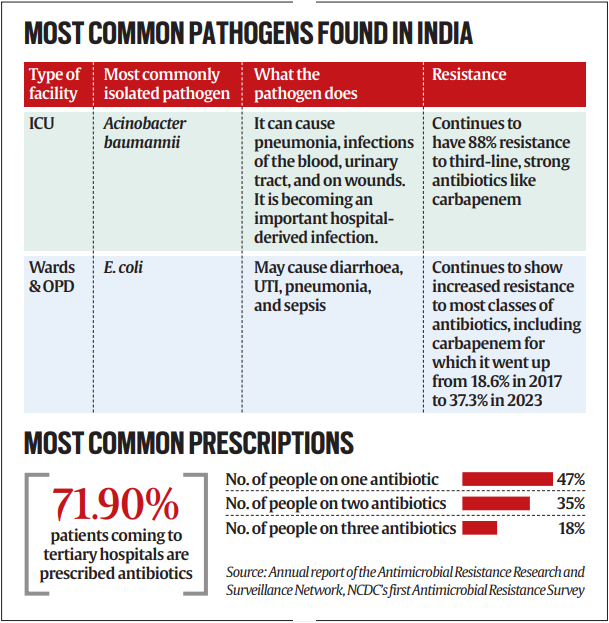11 September 2024 : Daily Current Affairs
1. Remove obstacles in the country’s research ecosystem, says Modi
- 1. Remove obstacles in the country’s research ecosystem, says Modi
- 2. On ANI’s defamation suit against Wikipedia
- 3. Rising Antimicrobial Resistance: A Global Health Crisis Fueled by Misuse and Pollution
- 4. Combination of ‘Siddha’ Drugs Reduces Anaemia in Adolescent Girls: Study
- Prelims Facts
- 1. ‘India has a four-point principle to end the Russia-Ukraine conflict’
- 2. Understanding ovarian cancer: its causes, symptoms, and screening methods
- 3. SpaceX’s Polaris Dawn Mission Aims for Historic Private Spacewalk and Advanced Space Research
- 4. Study Reveals Accelerated Brain Aging in Girls Due to COVID-19 Lockdowns
- 5. Tamil Nadu Secures Rs 2,666 Crore Investment, Over 5,300 Jobs in Electronics Manufacturing Boost
(Source – The Hindu, International Edition – Page No. – 4)
| Topic: GS2 – Social Justice – Education, GS3 – Science and Technology |
| Context |
|

Prime Minister Modi’s Vision for ANRF and Research Ecosystem:
- Prime Minister Narendra Modi chaired the first Governing Board meeting of the Anusandhan National Research Foundation (ANRF).
- He emphasised the need to overcome obstacles in India’s research ecosystem and urged a focus on ambitious, innovative research.
- Modi highlighted that solutions to global problems should be localised to suit Indian needs.
- A ‘hub and spoke model’ program will pair nascent research universities with established institutions for mentorship.
- The Governing Board discussed strategic interventions, including India’s global positioning, R&D alignment with national priorities, and promoting industry-aligned translational research.
| Anusandhan National Research Foundation (ANRF) |
|
| PYQ: Scientific research in Indian universities is declining, because a career in science is not as attractive as our business operations, engineering or administration, and the universities are becoming consumer oriented. Critically comment. (200 words/12.5m) (UPSC CSE (M) GS-3 2014) |
| Practice Question: What are the key obstacles in India’s research ecosystem, and how can policy interventions address these challenges to promote innovation and scientific development? (150 Words /10 marks) |
2. On ANI’s defamation suit against Wikipedia
(Source – The Hindu, International Edition – Page No. – 10)
| Topic: GS2 – Governance |
| Context |
|
Reasons for the Suit Filed by ANI:
- ANI sued the Wikimedia Foundation, alleging defamation due to a description on Wikipedia portraying it as a “propagator of government propaganda.”
- ANI claimed that the page falsely depicted the agency as involved in distributing materials from fake news websites and misreporting events.
- The agency sought ₹2 crore in damages for the perceived harm to its reputation.
Concerns Raised by ANI:
- ANI highlighted concerns over Wikipedia’s portrayal of its work, accusing the platform of facilitating unverified claims and unreliable sources.
- The defamation claim primarily focuses on ANI being labelled as a tool for government propaganda, which it disputes.
Delhi High Court’s Involvement:
- The Delhi High Court, led by Justice Navin Chawla, ordered the Wikimedia Foundation to serve three Wikipedia users with summons, demanding their identification.
- The judge threatened to direct the Indian government to block access to Wikipedia if the Foundation didn’t comply with these demands.
Potential Implications:
- This case raises concerns about freedom of speech and the potential for government intervention in online content.
- If Wikipedia is blocked, it could set a precedent for censorship in India, possibly leading to more lawsuits from individuals and organisations displeased with their portrayals.
- The case also highlights the tension between maintaining neutrality on Wikipedia and addressing allegations of bias and defamation.
Global Context:
- Similar cases of censorship and lawsuits against Wikipedia have emerged in countries like Russia and China, where the site has been restricted or censored.
| PYQ: What do you understand about the concept “freedom of speech and expression”? Does it cover hate speech also? Why do the films in India stand on a slightly different plane from other forms of expression? Discuss. (200 words/12.5m) (UPSC CSE (M) GS-2 2014) |
| Practice Question: Evaluate how legal challenges, like the ANI-Wikipedia defamation lawsuit, affect the balance between freedom of speech and protection against defamation in digital media. (150 Words /10 marks) |
3. Rising Antimicrobial Resistance: A Global Health Crisis Fueled by Misuse and Pollution
(Source: Indian Express; Section: Explained; Page: 15)
| Topic: GS3 – Science and Technology |
| Context: |
|
Analysis of News:
What is AMR and Why is it a Concern?
- AMR occurs when pathogens evolve to survive antimicrobial drugs, often due to misuse or overuse of antibiotics.
- This leads to the emergence of superbugs, which are resistant to common treatments, making simple infections harder to treat.
- AMR increases healthcare costs, leads to longer hospital stays, and results in more severe complications.
Causes of AMR


Individuals
- Many Indians misuse antibiotics, taking them for viral infections or without a prescription.
- This misuse fuels resistance. Prevention through hygiene practices and vaccinations could help reduce the need for antibiotics.
Doctors
- Doctors often prescribe broad-spectrum antibiotics, contributing to resistance. Empirical prescriptions based on symptoms instead of diagnostic tests further exacerbate the problem.
Pharmaceutical Pollution
- Pharmaceutical companies contribute to antibiotic resistance by releasing waste that fosters the growth of resistant bacteria. The WHO has introduced guidelines for better waste management to curb this issue.
Key Resistant Pathogens in India

The ICMR surveillance report highlights three main resistant pathogens:
- E. coli,
- Klebsiella pneumoniae, and
- Acinetobacter baumannii.
These pathogens are becoming increasingly resistant to even strong antibiotics, making infections difficult to treat.
Strategies to Combat AMR
- Prevention: Improve hygiene, sanitation, and vaccination to reduce infections.
- Education: Train doctors to use antibiotics judiciously and conduct diagnostic tests before prescribing.
- Regulation: Implement stronger regulations on antibiotic manufacturing and its environmental impact to prevent pollution-driven resistance.
| What are the Measures Taken to Address AMR ? |
|
Indian: National Programme on AMR containment:
National Action Plan on AMR:
AMR Surveillance and Research Network (AMRSN):
AMR Research & International Collaboration:
Antibiotic Stewardship Program:
Global Measures: World Antimicrobial Awareness Week (WAAW):
The Global Antimicrobial Resistance and Use Surveillance System (GLASS):
Global Point Prevalence Survey Methodology:
|
| PYQ: Can overuse and the availability of antibiotics without doctor’s prescription, the contributors to the emergence of drug-resistant diseases in India? What are the available mechanisms for monitoring and control? Critically discuss the various issues involved. (200 words/12.5m) (UPSC CSE (M) GS-3 2014) |
| Practice Question: Analyze the significance of the new semiconductor partnership between India and the US. How might this collaboration impact both nations’ semiconductor industries and their broader technological strategies? (250 words/15 m) |
4. Combination of ‘Siddha’ Drugs Reduces Anaemia in Adolescent Girls: Study
(Source – https://pib.gov.in/PressReleseDetail.aspx?PRID=2053375 )
| Topic: GS2 – Social Justice – Health |
| Context |
|
What is Siddha Medicine?
- Siddha medicine is an ancient system of healing that originated in South India.
- It is part of the traditional Indian medical practice, focusing on achieving balance among the body’s three fundamental elements—vata, pitta, and kapha.
- Siddha uses natural remedies, including herbs, minerals, and dietary practices, to treat diseases and promote health.
- It emphasises holistic care, integrating physical, mental, and spiritual aspects.
- Siddha medicine is recognized for its detailed diagnostic methods and therapeutic techniques.
What is Anaemia?

- Anaemia is a condition where the blood has a lower-than-normal number of red blood cells or haemoglobin, reducing its ability to carry oxygen.
- Common symptoms include fatigue, weakness, paleness, and shortness of breath.
- It can result from various causes, including nutritional deficiencies (iron, vitamin B12), chronic diseases, or genetic disorders.
- Treatment depends on the underlying cause and may include dietary changes, supplements, or medications.
- Recent data shows that approximately 60% of children and 50% of women of reproductive age in India are affected.
Prelims Facts
1. ‘India has a four-point principle to end the Russia-Ukraine conflict’
(Source – The Hindu, International Edition – Page No. – 4)
| Context |
|

India’s Four-Point Principle on Russia-Ukraine Conflict:
- India believes in pursuing peace, not war.
- War cannot resolve the conflict; negotiations are essential.
- Russia must be included in any successful peace process.
- India remains concerned and engaged in seeking a resolution.
India’s Role Amid The Conflict:
- India has not committed to hosting or proposing a peace conference on the Russia-Ukraine conflict.
- External Affairs Minister S. Jaishankar highlighted India’s ongoing engagement, noting National Security Adviser Ajit Doval’s visit to Russia.
- India’s previous position was that the conflict was a European issue rather than one directly affecting India.
2. Understanding ovarian cancer: its causes, symptoms, and screening methods
(Source – The Hindu, International Edition – Page No. – 11)
| Context |
|
Ovarian Cancer:

Causes:
- Genetics: Changes in certain genes can greatly increase the risk of ovarian cancer.
- Endometriosis: A condition where tissue similar to the uterus grows outside it can slightly increase the risk of some ovarian cancers.
- Lifestyle Factors: Using talcum powder or certain hair products might be linked to ovarian cancer. Hormone replacement therapy (HRT) might also raise the risk.
Symptoms:
- Common Signs: Feeling bloated, pain in the lower abdomen or pelvis, losing appetite, feeling full quickly, needing to urinate often, and having back pain. Other signs include tiredness, weight loss, and bleeding after menopause.
- Symptom Frequency: Women with ovarian cancer might have these symptoms 20-30 times a month, and they are usually more intense than common ailments.
Screening Methods:
- No Regular Tests: There are no standard tests for early detection like those for other cancers.
- CA125 Test: This test can help monitor the disease after it’s diagnosed but isn’t reliable for screening healthy women because it might give false positives.
3. SpaceX’s Polaris Dawn Mission Aims for Historic Private Spacewalk and Advanced Space Research
(Source: Indian Express; Section: Explained; Page: 15)
| Context: |
|
Analysis of News:
What is a Spacewalk?
- A spacewalk, or extravehicular activity (EVA), refers to any activity performed by astronauts outside their spacecraft.
- Spacewalks are conducted for various purposes, including testing equipment, repairing spacecraft, and conducting experiments.
Crew and Mission Objectives
- The crew includes Isaacman, retired US Air Force officer Scott Poteet, and SpaceX engineers Anna Menon and Sarah Gillis.
- They aim to reach 1,400 km from Earth, surpassing past records, and will conduct scientific experiments, including a spacewalk to test SpaceX’s new EVA spacesuits.
Scientific Goals
- The mission seeks to gather data on space radiation effects on human health and explore laser-based communications.
- The spacewalk is scheduled to test the newly designed spacesuits, marking a significant milestone in space exploration.
4. Study Reveals Accelerated Brain Aging in Girls Due to COVID-19 Lockdowns
(Source: Indian Express; Section: Explained; Page: 15)
| Context: |
| A study conducted by the University of Washington, published in Proceedings of the National Academy of Sciences, examined adolescent brain development before and after the COVID-19 lockdowns in the U.S. Researchers discovered that girls’ brains aged faster than expected due to social isolation. |
Analysis of News:

Cortical Thinning Process
- Cortical thinning is a natural part of brain maturation, beginning in late childhood or early adolescence, involving the pruning of redundant synapses.
- This process is typically associated with increasing brain efficiency. However, it is known to accelerate under stressful conditions and is linked to anxiety and depression.
Study Findings
Scans from 2021, after the lockdowns, showed both boys and girls experienced accelerated cortical thinning. However, the effect was significantly more pronounced in girls:
- Girls: Thinning accelerated by 4.2 years beyond what was expected.
- Boys: Thinning accelerated by 1.4 years beyond the expected rate. The study suggested that a 14-year-old girl’s brain resembled that of an 18-year-old due to this accelerated development.
Social Isolation Impact
- Experts attributed the accelerated brain maturation in girls to the social deprivation caused by the pandemic.
- Girls are more reliant on social interaction, particularly discussing problems with friends to relieve stress, which may have exacerbated the effects.
Debate on Cortical Thinning
- Other researchers cautioned against interpreting accelerated thinning as damage.
- While the thinning could be problematic, it may also represent a normal maturational change rather than a sign of harm.
5. Tamil Nadu Secures Rs 2,666 Crore Investment, Over 5,300 Jobs in Electronics Manufacturing Boost
(Source: Indian Express; Section: Express Network; Page: 12)
| Context: |
|
Analysis of News:
Investments and Job Creation
- Agreements with Jabil Inc. and Rockwell Automation are projected to bring in Rs 2,666 crore and create over 5,300 jobs in Tamil Nadu’s Tiruchi and Kancheepuram districts.
- An additional Memorandum of Understanding (MoU) with Autodesk focuses on enhancing youth skills and improving the competitiveness of small and medium enterprises (SMEs) in the state.
Commitment to Manufacturing Growth
- Jabil Inc. and Rockwell Automation committed to expanding their operations in Tamil Nadu.
- Chief Minister Stalin welcomed these investments, emphasizing that Jabil’s presence in Tiruchirappalli will stimulate local job creation and further develop a robust electronics supply chain, reinforcing Tamil Nadu’s position as a leader in advanced electronics and innovation.
Government’s Vision for Industrial Growth
- The Tamil Nadu government highlighted its ongoing initiatives to fully utilize the state’s resources, promote industrial growth, and improve the quality of life for its citizens.
- As a result, Tamil Nadu has emerged as a leader across various economic indicators in India.



